If you’re a researcher, how do you think your journal is being measured based on the importance level? That’s where Eigenfactor comes in.
It is an interesting metric that helps you decide the impact of your journal in the community. This is what we are going to see in this article, an in-depth analysis of Eigenfactor. So, let us dig deeper and carry on with the journey to understand everything about Eigenfactor:
What is Eigenfactor?
The Eigenfactor is a metric that helps you understand the impact of academic journals. It’s different from other citation metrics because it doesn’t just count how many times a journal is cited. Instead, it considers the quality of the citations by giving more weight to citations from influential journals.
In simple terms, the Eigenfactor measures how important a journal is within the academic community. If a journal is cited by other well-respected journals, its Eigenfactor score will be higher. This makes it a valuable tool for you when determining which journals have a strong reputation.
Unlike some other metrics, the Eigenfactor also takes into account the size of the journal and adjusts for self-citations. So, it provides a more balanced view of a journal’s influence. You can use the Eigenfactor to compare journals and decide which ones are making a real impact in their field.
Overall, the Eigenfactor offers you a clear picture of a journal’s importance beyond just the number of citations it receives.
How is the Eigenfactor Calculated?
The Eigenfactor is calculated by looking at the number of times articles from a journal are cited in other journals over a five-year period.
However, not all citations are treated equally. Citations from highly influential journals are given more weight, meaning they contribute more to the Eigenfactor score.
Additionally, the Eigenfactor adjusts for the size of the journal, so larger journals don’t automatically have higher scores. Self-citations, where a journal cites itself, are also minimized in the calculation to provide a more accurate measure of a journal’s influence.
Overall, the Eigenfactor gives you a clearer view of a journal’s real impact by focusing on meaningful citations rather than just counting them.
Importance and Application of Eigenfactor
The purpose of the Eigenfactor is to help you identify which journals have a strong influence in their field, making it easier to determine which sources are most valuable in academic publishing.
Why the Eigenfactor Matters
The Eigenfactor is important because it provides a deeper insight into the influence of academic journals, beyond just counting citations. It helps you understand not only how often a journal is cited but also the quality of those citations, focusing on citations from respected and influential sources.
For academic journals, a high Eigenfactor score can enhance their reputation and attract more quality research submissions. As a researcher, it helps you identify journals that are truly impactful in their fields, guiding you in choosing where to publish or which journals to reference in your work.
The Eigenfactor offers you a more meaningful measure of influence compared to simpler metrics.
Practical Uses of the Eigenfactor
In practical terms, the Eigenfactor can be a useful tool in various decision-making processes. For example, if you’re deciding where to submit your research, you can use the Eigenfactor to choose journals with strong academic influence.
Universities and research institutions may use the Eigenfactor to assess the quality of research when making decisions about funding or evaluating academic performance.
By focusing on meaningful citations, the Eigenfactor helps ensure that decisions in academic publishing and research assessments are based on quality and not just quantity.
Comparisons with Other Metrics
Eigenfactor vs. Impact Factor
The Eigenfactor and Impact Factor are both used to measure the importance of academic journals, but they work in different ways. The Impact Factor calculates the average number of citations a journal receives in a given year, focusing purely on citation counts.
In contrast, the Eigenfactor considers both the number and quality of citations, giving more weight to citations from influential journals.
The main advantage of the Impact Factor is its simplicity—you can quickly see how often a journal is cited. However, it has limitations, such as not considering the quality of citations and being more easily influenced by self-citations.
The Eigenfactor, on the other hand, provides a more comprehensive view of a journal’s influence but is more complex to calculate and understand.
Eigenfactor vs. h-index
The h-index is another metric, but it’s different from both the Eigenfactor and Impact Factor because it measures an individual researcher’s impact rather than a journal’s. It looks at the number of papers a researcher has published and how many times each paper has been cited.
The h-index is useful for evaluating individual researchers but doesn’t account for the quality of citations or the impact of journals where the work is published. The Eigenfactor, by focusing on journals, provides you with a broader view of academic influence but isn’t helpful for assessing individual researchers.
Limitations and Criticisms
Limitations of the Eigenfactor
While the Eigenfactor is a valuable metric, it does have some limitations. One potential bias is that it tends to favor larger journals since they generally receive more citations. This can make smaller, yet highly specialized journals appear less influential, even if they have a strong impact within their niche.
Additionally, the Eigenfactor focuses on the overall influence of journals, not individual articles, which may not fully capture the value of groundbreaking research that appears in lesser-known publications. Another limitation is that it relies on citation data, which can be slow to accumulate, meaning newer journals or emerging fields might be underrepresented.
Addressing the Criticisms
Common criticisms of the Eigenfactor include its complexity and the potential for bias towards established journals. Some argue that the focus on quality citations might overlook important but less frequently cited work.
In response, proponents of the Eigenfactor highlight that its strength lies in providing a more nuanced view of a journal’s influence compared to simpler metrics.
While no metric is perfect, the Eigenfactor aims to balance quantity and quality, offering you a more comprehensive picture of a journal’s impact. Critics also acknowledge that, despite its flaws, the Eigenfactor adds valuable depth to the evaluation of academic journals.
Conclusion
In conclusion, the Eigenfactor is a valuable metric for assessing the influence of academic journals by considering both the quantity and quality of citations. It offers a more nuanced view than simpler metrics like the Impact Factor by giving more weight to citations from reputable sources.
However, the Eigenfactor has its limitations, such as favoring larger journals and being complex to calculate. While it has faced criticisms for potential biases, it remains a useful tool for decision-making in academic publishing and research assessment.
Overall, the Eigenfactor provides you with a more comprehensive understanding of a journal’s impact, balancing the strengths and weaknesses of other metrics.
Visualize Your Research Or Paper In An Engaging Way
Mind the Graph is an exclusive platform that allows scientists to visualize their research or paper in an engaging way. With a wide variety of templates across different scientific fields, you can choose the ones that suit your research topic. And the best part is, if you don’t find the right infographic, our team of experts are ready to customize or create a visual that can enhance your research quality. Hurry up! Sign up now to explore more!

Subscribe to our newsletter
Exclusive high quality content about effective visual
communication in science.





